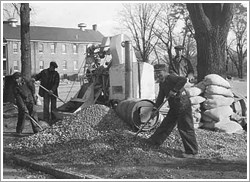
Minnesota Historical Society The Great DepressionThe stock market crash in October of 1929 ushered in the decade-long, worldwide economic depression. In response to the downturn, President Franklin Delano Roosevelt, with the help of Congress, established a suite of programs known collectively as the New Deal. These programs focused on relief for the unemployed and poor, economic recovery, and reform of the financial system to prevent another depression. Over 100 agencies were created to carry out the New Deal reforms, the largest of which was the Works Progress Administration (WPA). The function of the WPA was to employ millions of workers to carry out public works projects, including the construction of public buildings and infrastructure. Between 1935 and 1942, the WPA provided almost eight million jobs to American workers affected by the Great Depression. One of the most popular of the New Deal agencies--the Civilian Conservation Corps (CCC)--also employed jobless Americans to build parks, roadways and buildings. Though smaller in scale, employing three million young men, the CCC focused on the conservation and development of natural resources in rural areas and was responsible for the construction and establishment of many local, state and national parks. These agencies facilitated the recovery of the U.S. economy and provided relief to millions of poor and unemployed American workers. Benefits of the New Deal at Fort SnellingFort Snelling benefited from New Deal programs such as the Works Progress Administration (WPA) and the Civilian Conservation Corps (CCC). The programs provided funding for a general reconditioning of the fort, including landscaping and infrastructure. Workers graded and resurfaced existing roads, built new sidewalks and curbs and installed new sewer and water mains. They removed trees and cleared brush, drained swamps, and built a running track and multiple baseball diamonds. Repairs to several barracks buildings, officers' quarters, and the frontier fort's retaining wall were also completed. New construction projects included 200 garage spaces, a two story addition to the quartermasters building, a bakery, barracks, and a telephone exchange. During the 1930's, the Fort employed 200 to 300 active members of the CCC and WPA. |
Last updated: November 22, 2019
